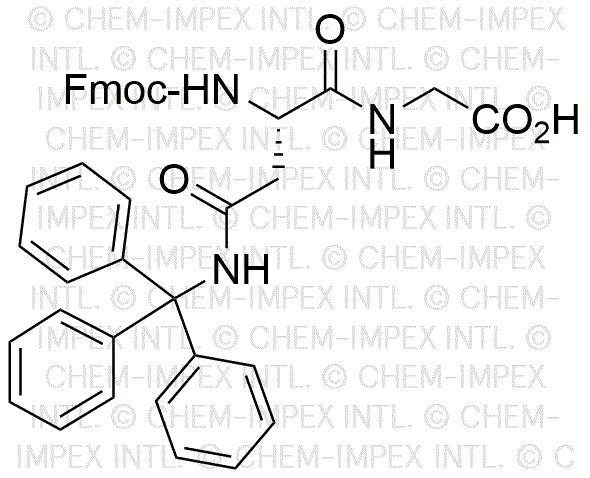Fmoc-Asn(Trt)-Gly-OH is widely utilized in research focused on:
- Peptide Synthesis: This compound is a key building block in the synthesis of peptides, particularly in solid-phase peptide synthesis (SPPS), allowing for the creation of complex peptide structures efficiently.
- Drug Development: It plays a crucial role in the development of peptide-based therapeutics, offering a way to modify peptide sequences for enhanced stability and bioactivity, which is essential in pharmaceutical research.
- Bioconjugation: Used in bioconjugation techniques, it enables the attachment of peptides to various biomolecules, facilitating the creation of targeted drug delivery systems and diagnostic agents.
- Protein Engineering: This compound aids in the design of modified proteins with specific functionalities, helping researchers to tailor proteins for industrial applications, such as enzyme production or biosensors.
- Research in Neuroscience: It is utilized in studies related to neuropeptides, contributing to the understanding of neurological processes and potential treatments for neurodegenerative diseases.
General Information
Properties
Safety and Regulations
Applications
Fmoc-Asn(Trt)-Gly-OH is widely utilized in research focused on:
- Peptide Synthesis: This compound is a key building block in the synthesis of peptides, particularly in solid-phase peptide synthesis (SPPS), allowing for the creation of complex peptide structures efficiently.
- Drug Development: It plays a crucial role in the development of peptide-based therapeutics, offering a way to modify peptide sequences for enhanced stability and bioactivity, which is essential in pharmaceutical research.
- Bioconjugation: Used in bioconjugation techniques, it enables the attachment of peptides to various biomolecules, facilitating the creation of targeted drug delivery systems and diagnostic agents.
- Protein Engineering: This compound aids in the design of modified proteins with specific functionalities, helping researchers to tailor proteins for industrial applications, such as enzyme production or biosensors.
- Research in Neuroscience: It is utilized in studies related to neuropeptides, contributing to the understanding of neurological processes and potential treatments for neurodegenerative diseases.
Documents
Safety Data Sheets (SDS)
The SDS provides comprehensive safety information on handling, storage, and disposal of the product.
Product Specification (PS)
The PS provides a comprehensive breakdown of the product’s properties, including chemical composition, physical state, purity, and storage requirements. It also details acceptable quality ranges and the product's intended applications.
Certificates of Analysis (COA)
Search for Certificates of Analysis (COA) by entering the products Lot Number. Lot and Batch Numbers can be found on a product’s label following the words ‘Lot’ or ‘Batch’.
Número de catálogo
Número de lote/lote
Certificates Of Origin (COO)
This COO confirms the country where the product was manufactured, and also details the materials and components used in it and whether it is derived from natural, synthetic, or other specific sources. This certificate may be required for customs, trade, and regulatory compliance.
Número de catálogo
Número de lote/lote
Safety Data Sheets (SDS)
The SDS provides comprehensive safety information on handling, storage, and disposal of the product.
DownloadProduct Specification (PS)
The PS provides a comprehensive breakdown of the product’s properties, including chemical composition, physical state, purity, and storage requirements. It also details acceptable quality ranges and the product's intended applications.
DownloadCertificates of Analysis (COA)
Search for Certificates of Analysis (COA) by entering the products Lot Number. Lot and Batch Numbers can be found on a product’s label following the words ‘Lot’ or ‘Batch’.
Número de catálogo
Número de lote/lote
Certificates Of Origin (COO)
This COO confirms the country where the product was manufactured, and also details the materials and components used in it and whether it is derived from natural, synthetic, or other specific sources. This certificate may be required for customs, trade, and regulatory compliance.


